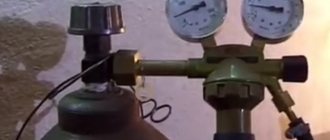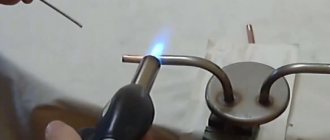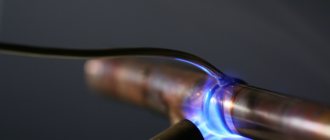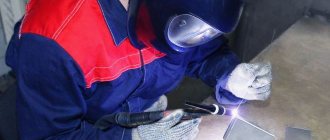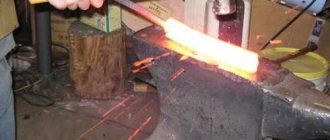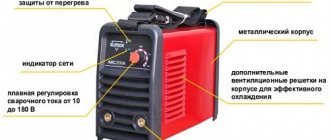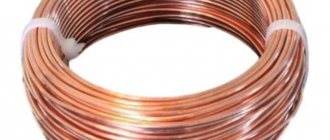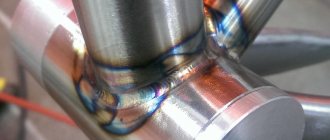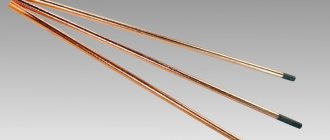Argon welding is often used to connect copper elements. The technology is that the procedure is performed in an inert gas environment. Argon protects the welded area from oxygen entering it, thereby preventing the metals from oxidizing. This method is effective when it is necessary to make a connection from copper or its alloys. Argon arc welding perfectly protects the weld pool and molten filler material, so it is considered optimal.
Copper alloys have good electrical conductivity, are resistant to corrosion and have high heat transfer rates. Copper begins to melt at a temperature of 1083 °C. This is twice as much as aluminum. But when compared with stainless steel, copper alloys also require protection with argon. That is, to obtain high characteristics of the weld and avoid corrosion, it is necessary to heat the metal evenly.
Work is carried out with several grades of copper and its alloys. To form a reliable weld, it is necessary to use deoxidized or oxygen-free copper. The less oxygen, the better. For better welding, flux is used. It is applied to thin rods and promotes better melting and adhesion of the metal.
A little theory
Copper and its alloy (bronze and nickel) are used in many industries due to their electrical and thermal conductivity and anti-corrosion properties. Melting point of the material is 1083°C. The thermal conductivity of pure copper is 2 times greater than that of aluminum, therefore, when welding with argon, good heating of the metal is necessary.
But the thermal conductivity of the copper alloy is already lower, which means there is no need for increased heating.
Copper and alloys are divided into several grades. To obtain a high-quality welded joint, it is better to use deoxidized or oxygen-free copper, as they contain little oxygen.
The main filler compositions for welding copper with argon are presented in the table.
But in practice, metals of similar composition are usually used (what can be found in a home workshop).
Also, for better melting and fusion of metal, rods with a thin coating of a layer of flux are used.
TIG welding technique
When TIG welding, the side angle of the torch should always be maintained at 90 degrees. The torch should be held at an angle. While the angle of inclination of the torch to the surface of the product in the direction opposite to welding should be 70 ... 80 degrees. The additive is supplied as the torch moves at an angle of 15 to 30° to the base metal.
TIG welding is performed at a “forward angle” (i.e., the torch is tilted towards the forming weld) with regular addition of the additive in small steps. When welding, it is very important that the end of the filler wire does not move out of the gas protection zone; otherwise, when molten or heated, it will oxidize from contact with the surrounding air. Any degree of oxidation or contamination of the filler wire will inevitably cause contamination of the weld pool. It is therefore very important that the welder uses filler ponds that are free of dirt, grease or moisture. Typically, dirt and grease are transferred to the filler metal from dirty gloves. Therefore, immediately before welding, it is very advisable to treat the rods, for example, with acetone. Lubrication and moisture on both the filler rod and the base metal can cause serious weld defects such as porosity, hydrogen cracking, etc.
Material properties
To weld copper or copper-based alloys, it is necessary to perform high-quality heating of the structures. Thanks to excellent thermal conductivity, it is quite easy to ensure uniform temperature on the surface of the part and throughout the thickness of the material. However, obtaining a uniform, strong seam requires the use of certain skills.
Welding Features:
- with a significant increase in temperature, oxidation processes begin to occur in copper, as a result of which refractory phases of increased fragility are created, which negatively affects its strength and plastic properties;
- During cooling of the seam, significant shrinkage occurs, which can cause cracks;
- as a result of heating, the absorption of gases begins, increasing the likelihood of the formation of unevenness and cavities;
- welds at the junctions of copper with stainless steel and other metals have a high level of granularity associated with the heterogeneity of the materials, the connection becomes brittle and unreliable;
- due to high electrical conductivity, high currents are required on the welding machine, which makes household inverters unsuitable for welding work;
- Due to the high level of metal fluidity when heated, creating seams in a vertical or ceiling position is impossible.
Difficulties in fusion welding of aluminum and copper products
It is quite difficult to weld copper to aluminum using fusion welding.
This happens due to the fact that the composition of the molten metal is almost impossible to regulate, and the mechanical properties of the welded joint strongly depend on the copper content in it, this is clearly visible from the diagram (see figure on the left). If the copper content in a copper-aluminum alloy exceeds 12%, then the tensile strength stops increasing, and the toughness of the alloy and its corrosion resistance drop sharply. Therefore, when the copper content in the weld metal is more than 12%, the joint becomes very brittle and prone to cracking after welding.
Practical studies on welding aluminum and copper using a carbon electrode have not yielded positive results. It is possible to join copper and aluminum using fusion welding if the material being melted is predominantly aluminum. The so-called “lock” connection is often used, where possible.
"Lock" connection between aluminum and copper
The essence of the “lock” connection (see figure on the left) is as follows. A copper plate, item 2, is placed on the aluminum sheet, item 1, and it is welded around the entire perimeter, flush with the plate. Next, surfacing is performed, position 3, which connects the welds deposited along the perimeter of the copper plate. This creates something like an aluminum alloy lock. The welding process must be carried out with forming graphite strips.
Welding modes for aluminum and copper
The welding modes for aluminum and copper are very similar to the welding modes for aluminum. The nature of the welding current is constant, straight polarity. Cast aluminum rods with a diameter of 12-20mm for a thickness of aluminum of 29-30mm and copper of 10mm are used as filler material. Welding current strength is 500-550A. The electric arc voltage is 50-60V, and its length is 20-25mm. For welding, graphite electrodes with a diameter of 15-20 mm are selected.
Features of working with copper
Although welding copper parts can be done using special electrodes, it is still best to use non-consumable tungsten electrodes for these purposes.
Such electrodes “boil” seams well, unlike welding with conventional electrodes, they turn out strong, smooth and clean.
Since a mixture of gases is used during welding: argon and nitrogen, for safety reasons welding should only be performed by a specially trained welder.
Tungsten non-consumable electrodes come in several types: EVL and EVI. EVL are laptanized electrodes, and EVI are iterated electrodes.
To weld copper parts using argon, iterated tungsten electrodes are used. If the thickness of copper parts welded with argon exceeds 5 mm, then mandatory edge cutting is used.
Without cutting the edges, it will be impossible to heat the entire thickness of the metal, since copper has high thermal conductivity.
You should know that for metal with a thickness of 5–12 mm, one-sided cutting is used, and if the metal thickness is greater than the specified one, then both edges of the workpiece are cut.
The quality of the weld also depends on the impurities contained in the copper - the purer the copper, the better the quality of the weld. In addition to tungsten electrodes, filler wire is also used.
The filler wire insulates the parts being welded from oxygen that does enter the welding area.
Copper welding mode table
The material of the filler wire must certainly correspond to the composition of the metal that is supposed to be welded.
As an additive, you can take copper wire, which contains a large amount of manganese. On the one hand, manganese reliably binds oxygen entering the welding area, but on the other hand, manganese impurities reduce the strength of the weld.
Therefore, it is best to use wire containing some rare earth materials as an additive.
Gas welding
Using gas welding of copper, subject to the technological process of the work, you can obtain a reliable and high-quality seam. To do this you will need an acetylene cylinder and a torch. Forging the seam surface will help improve quality. This method will close minor pores.
The only negative is the high gas consumption. For normal operation, it is necessary to maintain a strong flame in the burner. For parts with a thickness of 10 mm and above, the gas consumption will be 200 l/hour. To weld thick metal, you will have to use a cutter to heat up the copper, and use a small torch to make the seam.
To increase the time, with uniform cooling, copper parts are covered on all sides with asbestos sheets. The burner flame should be directed at the edges of the parts at right angles. The formation of areas with seam oxidation and cracks can be reduced by increasing the welding speed and performing it without breaks.
The main difference between joining copper parts is the absence of tacks when joining. For more accurate assembly, it is better to carry out welding in a special device. Additive wire is used from various metals with deoxidizing agents. The largest wire cross-section is no more than 8 mm, for thick metal.
When welding, pay attention to the process of melting the edges of parts and additives. For a better weld, the additive should melt slightly before the edges of the base metal. When ensuring the welding of filler metal onto the edges, do not forget about joint penetration.
For better joint quality, the edges are cut when the copper thickness is more than 3 mm. They are cut to 450. The metal will fit better at the joint if it is pre-treated with a mixture of water and nitric acid. Then the surfaces are washed with water and work begins.
Finished joints must be forged at a temperature of about 3000 when gas welding copper with a thickness of over 5 mm. The seam is annealed at a temperature of no more than 5000. Then the parts should be cooled in water. When annealing at a higher temperature, the risk of getting a brittle joint with many cracks increases.
Features of copper argon arc welding
Copper itself, as well as alloys based on it, are fairly highly thermally conductive materials, which, among other things, also have high electrical conductivity, as well as high corrosion resistance both when exposed to external factors and relative to intracrystalline corrosion.
The melting point of copper in its pure form is 1083 °C, and if various alloying chemical compounds are added, this indicator may shift in one direction or the other.
A special feature of welding copper products and parts is the high thermal conductivity of this metal, which makes it necessary to preheat the parts before starting welding. Heating should be carried out to a temperature of 350 to 600 °C. Heating is usually carried out using a gas burner.
Welding is most often carried out using the argon arc method by using a non-consumable electrode with direct current. A rod made of pure copper or its alloys is used as a filler material. This allows you to achieve maximum quality of the seam, as well as its neat appearance.
If the materials are chosen incorrectly, the copper in the weld pool begins to boil, which causes the formation of a large number of pores in the resulting weld, and the connection itself becomes fragile and may break during operation.
Preparing parts for welding
Regardless of the method, copper blanks must be cleaned of dirt and then degreased. The oxide film is removed with a wire brush or fine-grained sandpaper using careful movements to avoid deep scratches. It is recommended to complete the cleaning by etching the welded parts and wire in an aqueous solution of nitric, hydrochloric or sulfuric acid. Then rinse with fresh water and dry with hot air.
The edges of workpieces 0.6 - 1.2 cm thick are chamfered so that an angle of 60 - 70⁰ is formed between them. When welding on both sides, it is reduced to 50⁰. If the thickness of the parts is more than 12 mm, the edges are cut in the form of the letter X for a two-way connection. If this is not possible, make a deep V-shaped cut. But filling the joint will require more consumables and time, since copper will have to be welded with a wide seam.
Features of copper argon welding
To weld copper or its alloys, it is necessary to carry out high-quality heating of the structure. Since the thermal conductivity of the material can be confidently called excellent, you just need to organize a uniform temperature over the entire thickness and surface of the part.
Although, of course, only an experienced craftsman will make a uniform, strong seam.
Features of copper argon welding:
- the procedure is performed in an inert gas environment;
- argon will protect the cooking area from oxygen penetration, thus preventing metals from oxidizing;
- the argon method will protect the weld pool, as well as the molten filler material;
- to form a reliable welding seam, you need to take oxygen-free or deoxidized copper (the less oxygen, the more successful the procedure);
- For better welding, flux is used.
Argon arc welding is suitable for connecting structures of different thicknesses (and large ones too). Before the procedure, the arc is heated on a carbon or graphite plate. You can cook in different positions: vertical, ceiling, bottom. Copper welding with argon is rated by experts as the cleanest. That is, oxide pairs are not actually released in this process. During argon welding, hot sparks do not fall on the floor, which is important for the safety of surfaces. That is, theoretically, argon welding can be carried out even in residential premises.
Finally, an important advantage of argon welding will be the quality of the process and the result. When welding copper with argon, you can count on a clean and neat seam, without undercuts and slag.
By the way, even thin-sheet copper products are cooked with argon at low currents. Another obvious advantage of argon welding is that it allows you to work even with complex metals that are resistant to conventional welding. It also makes it possible to restore the previous volume of the part (in this case, the metal is fused on top).
Benefits of using argon
The use of an argon protective atmosphere provides the following advantages:
- reduced sparking;
- good quality suture material;
- the ability to connect copper and stainless steel;
- welding of thin sheet parts with low current.
In addition, argon soldering of workpieces made of copper and its alloys; work in an argon environment makes it possible to weld the most refractory materials, as well as to carry out effective surfacing, restoring the shape of worn-out products.
How to prepare?
It must be said that copper is rarely used in its pure form, which cannot but affect the welding process. Impurities in the alloy provide high fluidity, greater sensitivity to oxygen, and intense evaporation of zinc. And the process is further complicated by high thermal expansion coupled with high thermal conductivity. All this complicates copper welding in principle. Therefore, preparation for welding is the most important stage of successful work.
The preparation process begins with high-quality cleaning work. The joint should be treated with abrasive until a characteristic shine appears. Then the work area must be degreased. The better the cleaning is done, the better the subsequent welding will be.
General characteristics of copper alloys
Pure copper is quite rare. This is due to several reasons. Firstly, such material has a high cost, and secondly, it is insufficiently durable. The main copper alloys that exist today are:
- Bronze;
- Brass.
Brasses are alloys of copper and zinc. In addition, to increase the strength characteristics and resistance to chemicals, additional components (nickel, silicon, etc.) can be added to such alloys.
Bronzes are metals that are obtained by mixing copper with tin, aluminum, silicon and other components, if zinc is not an alloying element. There are two main groups of this alloy:
- Tin;
- Special ones that contain chromium, aluminum, nickel, beryllium, cadmium, manganese as impurities.
Necessary equipment for argon welding of copper
Torches are the most important components for argon welding. RGA are the most popular models. GOST 5.917-71 describes the requirements for these devices.
Particularly popular models produced in accordance with GOST are RGA-150 and RGA-400. For welding currents up to 200 Amps, the first model is used. The diameter of the electrode for it is 0.8-3 mm. The second type of equipment can be used with current up to 500 Amperes. The diameter of the electrodes is 4-6 mm. It uses water cooling, unlike the first option, which only provides air cooling.
Do-it-yourself argon welding of copper
To weld copper alloys, take:
- burners in which a tungsten electrode is placed;
- argon storage cylinder;
- pressure reducer valves, the task of which is to regulate the supply of argon;
- safety equipment: protective mask and gloves minimum
Selecting Electrodes
To obtain a high-quality weld, it is necessary to select an electrode according to the diameter, composition of the coating, and the characteristics of the composition of the workpiece material. The composition of the coating plays a protective role, as it prevents gases from entering the melt.
When welding copper with argon, coatings and protective coatings make it possible to create special films. The coating contains additives that improve the weld when the electrode rod material comes into contact with the metal of the structure. In this case, the seam is formed homogeneously and hardens evenly, at the same time the creation of brittle phases is eliminated.
Two types of electrodes are used:
- non-melting, based on synthetic graphite, electrical coal, as well as other materials with similar properties.
- melting, created on the basis of rods made of copper, cast iron, aluminum wire, on top of which a special coating is applied.
To understand which electrode to weld copper with, you need to focus on the color of the coating:
- red – for manual welding;
- blue – for refractory alloys;
- gray – for welding parts made of non-ferrous metals.
Welding copper with argon
This method is used to weld copper using a semi-automatic or manual argon-arc method. The work is carried out with direct current of straight polarity. Its value is set on the basis that 100 A is needed for every millimeter of thickness. The value can be adjusted during operation depending on the composition of the metal. When welding copper with argon, the gas flow rate should not exceed 10 l/min.
Copper wires or cable cores, cleared of insulation and varnish, can be used as filler wire. It is fed along the edge of the weld pool in front of the electrode so that when melting the metal does not stick to it. For workpieces less than 0.5 cm thick, preheating is not required.
Most often, copper is welded with carbon electrodes, since tungsten electrodes have to be changed frequently. Workpieces with a thickness of more than 1.5 cm are connected with graphite electrodes. The permissible electrode extension is no more than 7 mm, the arc length is 3 mm. Unlike other methods, copper argon welding can be used to qualitatively connect vertical joints.
Work at home
At home, welding of small parts is sometimes required, so for most cases, ordinary copper wires are suitable as electrodes. All stages of work are determined by copper welding technology:
- Clean the rod from surface layers of varnish, oxide, grease or other types of contaminants. It is recommended to use wires with a minimum amount of impurities in the composition.
- During the welding process, additives are used to act as a protective medium from metal contact with air.
- The burner is ignited, the additive is placed in front of the seam, then the electrode, and heating is carried out behind them. The torch movements should be in a spiral towards the formation of the seam.
When welding thick parts, it is recommended to melt the base metal of the structure, but on the basis of which the connection is formed. In this case, the seam is clean and neat. In this case, additives are not used.
In an argon environment, the quality of the seam is achieved with a vertical position of the seam and horizontal welding.
Welding of thin parts is carried out in a stepwise manner. The method consists of performing welding at certain intervals, and then welding the missing areas until a uniform and high-quality seam is obtained.
Setting up the device
To achieve the quality of the connecting seam, you need to carefully select the parameters of the welding machines. It is necessary to weld pure copper at direct current with tungsten electrodes in a protective argon atmosphere. It is recommended to weld alloys using alternating current.
Beginners or inexperienced welders are recommended to use welding machines that have a selection of standard welding programs available. This will reduce the number of defective parts and increase work efficiency.
Current settings are selected depending on the following criteria:
- metal thickness;
- electrode wire diameter;
- type and diameter of filler rod.
In addition to argon, it is permissible to use nitrogen, helium, and mixtures of protective gases. Argon is effective and therefore is used more often than other gas mixtures.
Copper water pipes
Pipes can be welded using all copper welding methods.
You can weld copper with a carbon electrode or gas welding, but the most common and not very complicated method is argon welding. According to GOST, the seam must withstand water pressure of over 10 atmospheres when testing the water supply system. The operating principle is simple. Heat the joint, drip melt from the rod and slightly stretch the metal along the seam. This is how the entire perimeter of the pipe is cooked. Gradually adding metal and stretching it, a seam bead is formed. When welding copper without stopping, you will end up with a joint with many burns and undercuts in the seam.
To perform this type of work, it is better to use a pulse type welding machine. In this case, it is possible to increase the copper welding speed and reduce the deformation of the pipeline.
To do this, set short intervals between pulses, ensuring a slight cooling of the metal. If a hole has formed in the seam, do not rush to weld it. Let the metal cool and, moving along the edge of the hole, gradually weld it.
Before starting work, you need to adjust the current strength. To do this, it is better to use old pipeline parts. This method will save expensive material.
Copper Welding Machine
Quality welding machines for copper:
- – semi-automatic and automatic machines;
- – TIG – devices;
- – inverters.
Popular models are produced by TESLA, SPETSELECTROMASH, ESAB.
BUDDY TIG 160 from ESAB (pictured on the right) has two and four stroke torch firing modes. It can be used to join stainless steel and most other types of metals. It is compatible with almost any generator.
RENEGADE ES 300i ESAB inverter stores several welding parameters in its memory. Automatically sets the best starting parameters based on the configured current. It is lightweight but has high power.
Inverter machines allow you to weld copper rods; they generate a current of 60-110 amperes. For them you need to buy copper/carbon electrodes. HUNTER company produces semi-professional models, for example, MMA 257D, designed for continuous operation for two hours.
TESLA is known for reliable devices such as MMA 265, 275, 255. They have a non-contact arc excitation function. They connect to a regular household network without any problems. They are convenient for welding copper and its alloys, non-ferrous metals.
For welding with electrodes
Pulse-arc welding of copper plates is possible with tungsten electrodes in an argon atmosphere using an Orion 150s or 250s . They are lightweight and allow you to weld copper efficiently and reliably. The inverter welding device Resanta SAI-220 PN can be connected to a network with a voltage of 140-220 volts. It is easy to move with, it is equipped with a forced cooling system, so it does not overheat.
For wire welding
To perform copper wire welding work, the semi-automatic inverter Energomash SA-97PA20 is used. It has a light weight of 13 kilograms. It allows you to work with wire of different thicknesses 0.6-0.9 mm.
Smooth material feeding is ensured by the Shyuan MIG/MMA-290 model at a speed of 2.5-13 meters per minute. The device makes it possible to use 1-5 kilogram cassettes and allows you to work with electrodes.
The inverter semi-automatic welding machine Soyuz SAS-97PA195 is characterized by the presence of a 60 Volt idle speed function. It has an operating voltage adjustment range of 15-23 volts. A wire of 0.8-1 mm is suitable for it. It has a light weight of 10 kilograms, it is comfortable and reliable.
For welding copper wires
The TS-700-2 welding machine can connect copper conductors with a cross-section of 22 square meters. mm. It is compact, lightweight, weighs only four kilograms, is powered by a regular network, and consumes a little more than 1 kW. It can be carried in your bag. One carbon electrode is enough to make 700 welds.
It is recommended to weld copper strands using universal inverter machines, for example, RESANTA SAI-160, QUATTRO ELEMENTI A 160 Nano 643-255, SVAROG ARC 160 Easy Z213 H. The German device FUBAG IQ 160 makes it possible to set a current of 10-160 A. Its weight is almost seven kilograms, cost 7 thousand rubles (at the time of writing this article).
SVAROG ARC 160 Easy Z213 H from a Russian manufacturer has a stepless current regulator. It is convenient to use because the cable is connected via special connectors. Its weight is 4 kilograms, the approximate cost is 9 thousand rubles.
The functions of devices that greatly facilitate the welding process are:
– protection against sticking;
– the device does not respond to a current drop;
For your home, it is better to buy a device with a power of up to 4 kW. A current of 160 amperes is enough to weld metal 5 mm thick. The main selection criteria are the purpose of use, cost and set of functions.
